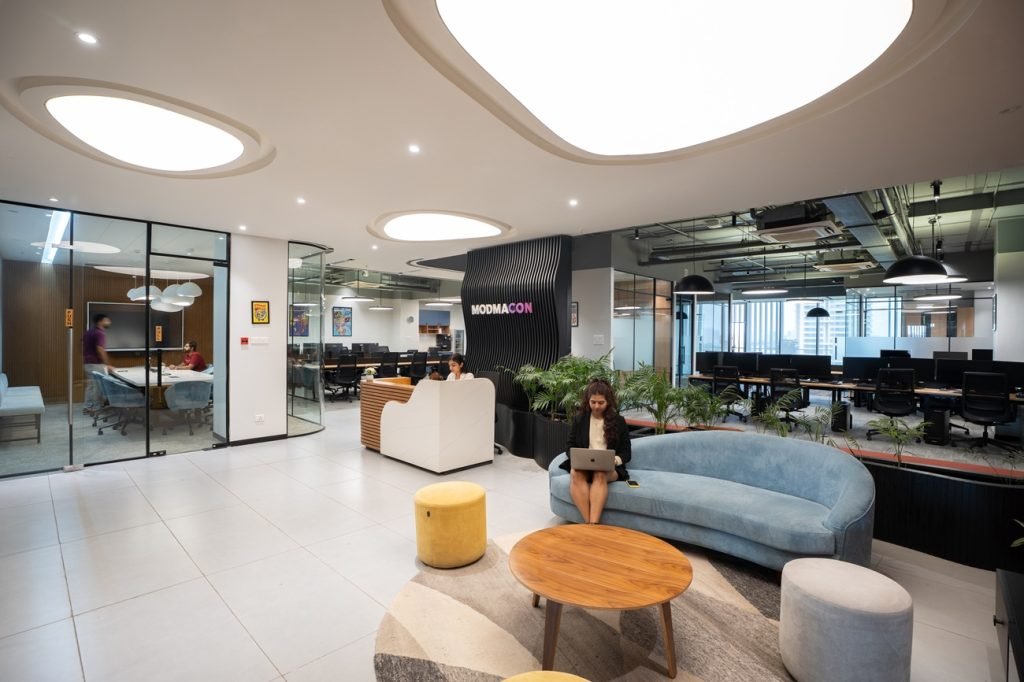Workplace design is a driver of culture, productivity, and impact. As businesses navigate hybrid work, shifting employee expectations, and rapid digital transformation, global giants are recognizing that office design can be their biggest advantage.

Office Design, an Investment
Traditionally, office spaces were seen as necessary but static. However, studies show a measurable link between workplace design and business performance. According to a Gensler Workplace Survey, high-performing workplaces are 4x more likely to prioritize space for collaboration, innovation, and focus. Meanwhile, other studies found that companies that redesign with a focus on wellness and engagement often see a 10–20% increase in employee productivity and a 25% reduction in absenteeism.
These are not marginal gains. For growing businesses and established enterprises alike, even modest improvements in performance, retention, and engagement can translate into millions in added value over time. Well-designed office interiors are strategic investments that yield sustained returns.
Aligning Design with Business Strategy
So, how can office design contribute directly to financial growth? It starts by aligning your workspace with your business goals:
- Attracting and retaining top talent: According to CBRE (2023), 72% of employees say that the ability to work in a well-designed office influences their decision to stay with a company.
Case Study: In our project for Mindtickle, we created a workspace that balances focus areas with wellness zones, relaxation spaces, and private pods, enhancing employee morale, engagement, and retention.
- Enabling collaboration and innovation: Workspaces that encourage movement, cross-functional interactions, and informal exchanges have been shown to encourage creativity and accelerate problem-solving.
Case Study: In our project for Digantara, the ceiling design became a key element, guiding direction and flow throughout the space. Each curve and light path was thoughtfully designed to lead movement, spark encounters, and create an environment that inspires innovation.
- Enhancing brand perception: The workplace is often the first physical impression for clients, investors, and partners. A space that reflects your brand values builds trust and confidence.
Case Study: Steepgraph Pvt Ltd redefines the modern office as its office design reinforces a strong brand perception among both clients and employees. The space clearly communicates that employees are valued and clients are a top priority.
- Improving operational efficiency: Well-planned layouts reduce wasted space, lower energy costs, and enable agility as teams evolve.
Case Study: Spero Healthcare is a testament to this approach. The office was designed to strike the right balance between affordability, functionality, and operational efficiency, demonstrating that good office design can deliver high performance without high costs.
A Case for Human-Centric, Data-Informed Design
It’s no longer enough to focus solely on aesthetics or seat counts. True financial returns come from creating environments that support health and human potential.
Research by Harvard Business Review shows that companies that prioritize employee experience outperform their competitors by 122%.
We adopt a human-centric and data-informed design philosophy. This means listening to users, leveraging workplace analytics, and building spaces that respond to how people truly work, not just how we assume they should.
For instance, a recent project, Tarz integrated height-adjustable desks, natural light optimization, and multi-use zones based on employee feedback and utilization data. The result is a 30% increase in collaboration metrics and a noticeable drop in meeting room bottlenecks.
Real Estate as a Growth Lever
In an era where every square foot matters, real estate decisions must be strategic. A poorly designed space can drain resources and morale. On the other hand, a right-sized, future-ready workspace can:
- Support scalability without constant expansion
- Enable hybrid and flexible work models
- Reduce the total cost of ownership through energy and space efficiency
- Provide a competitive edge in talent acquisition
Financial leaders are now increasingly involved in workspace discussions, recognizing that investing in office interiors is a smart move, one with long-term implications for ROI, cost optimization, and risk mitigation.
Looking Ahead: Designing for Resilience and Agility
The office of the future is adaptable, experiential, and aligned with evolving business needs. At Studio AsA, we believe the best workspaces are built around flexibility with modular furniture, movable partitions, acoustic zoning, and digital integrations that empower teams to reconfigure space as needed.
In today’s environment, growth doesn’t always mean more space; rather, it often means smarter space. One that encourages autonomy, fosters culture, and provides the right settings for people to do their best work.
In Closing
Rethinking office design is a strategic one. Leaders who view their workplace as a tool for growth are better positioned to drive performance, improve employee experience, and create long-term value.
Let’s design your next advantage.
Meet our team today!




